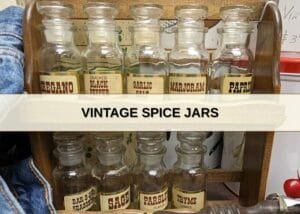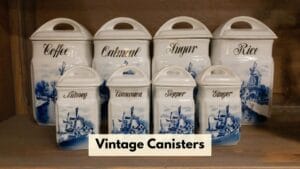Spice jars are one of the most common kitchen accessories in American homes. Today, these pieces come with unique designs, smooth mechanisms, and whatnot.
But would you believe me if I said that vintage spice jars could be more valuable than your modern pieces? Probably not, but it’s true! A rare Lexon spice jar set recently sold for a whopping $2,100!
So, if you have some old spice jars in your cabinets, this guide is for you! By the time you finish, you’ll know how to spot vintage pieces, know if they’re worth anything, and some rare sets that you may already own!
What Makes Spice Jars Collectible Today?
For most of history, spices were expensive luxury items, not cooking ingredients. Only wealthy people could afford them, and apothecaries stored them for medicinal use.
Early spice containers were made of wood, clay, or tin, designed to keep moisture and pests out. Apothecaries kept herbs and spices in rows of corked glass jars with handwritten labels. Things changed in the late 1800s as mass production made spices affordable.
Soon, glass companies like Hazel-Atlas and pottery makers like McCoy and Shawnee started producing matching spice jar sets with racks for display. Those plain, functional jars became decorative kitchen pieces, collectible today for their unique composition and craftsmanship!
Spotting Authentic Vintage Spice Jars (4 Key Features)
To be able to identify a vintage spice jar, you need to understand what features were common in early pieces, like materials and designs, which companies made them back in the day, and what techniques were used!
Read below to learn how these signs can help you spot and distinguish real vintage jars from modern replicas or dupes.
Materials
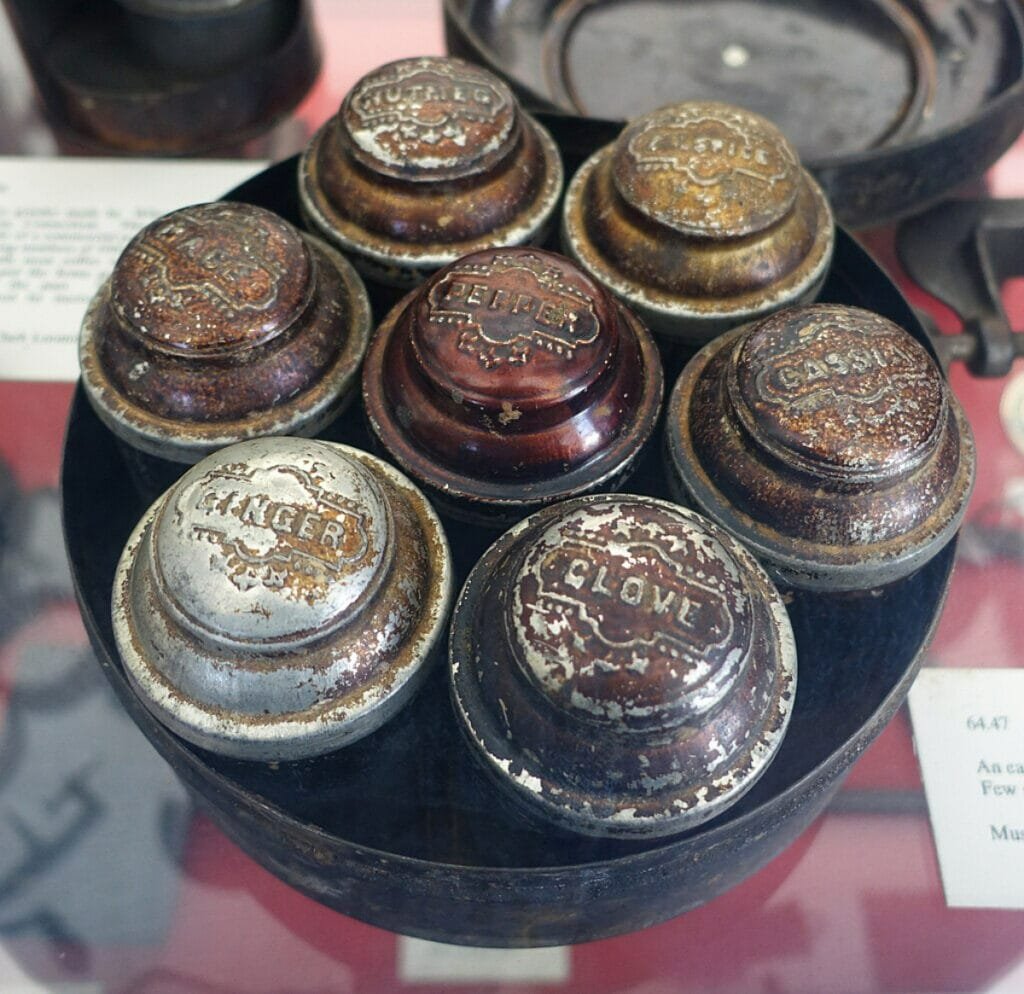
Spice jars were made back then with the same materials as they are today. So, checking the material is the first step to verifying vintage pieces and dating them. Some most common materials are:
1. Milk Glass:
Milk glass spice jars look exactly like they sound, white and milky, and they were popular from the 1930s to the 1950s. The white color comes from tin oxide or bone ash mixed into the glass, and it has depth, unlike the flat, chalky look of modern copies.
These jars are opaque, smooth, and have real weight to them. Old pieces may also have tiny imperfections or bubbles, while some may show fluted or ribbed patterns for grip and decoration.
2. Clear or Tinted Glass:
Clear or tinted glass was popularly used in mid-century and earlier spice jars. These were also quite popular because you could see what was inside without opening every jar.
Older glass jars generally have thicker glass walls than you’d find today, and a unique greenish tint common in old glass. These pieces may also show slight imperfections that show hand-blown or early machine work.
3. Ceramic and Porcelain:
These materials were common in luxury or decorative vintage spice jar sets. Lenox built their reputation on gorgeous porcelain sets like the famous Spice Village houses.
Ceramic spice jars are mostly hand-painted with intricate motifs, botanical prints, or cultural themes, or decorated with printed decals.
4. Metal (Tin & Aluminum):
Metal, especially tin, was mostly used for screw-on or hinged lids with those tiny holes for shaking spices. But some jars were entirely made of metal (mostly aluminum for lightweight) or a combination of a glass jar with a metal top.
Observe a distinctive patina and wear to spot and date authentic pieces.
5. Wood:
Wood was not as common for spice jars as other materials, but wooden racks and storage boxes are crucial parts of many sets. These pieces show real craftsmanship. Besides, the dovetail joints and other construction clues can also help you date the set.
Type of Spice Jars
Vintage spice jars came in different varieties. Understanding these can be a great clue to spot authentic pieces.
- Screw-Top Jars: These have threaded necks with metal or plastic lids that twist on tight. Most common type for mid-century kitchen sets like Tipp City rooster jars.
- Shaker-Top Jars: Feature perforated lids for sprinkling spices directly. Perfect for table use with salt, pepper, and seasonings. Often found in milk glass sets.
- Cork-Stopper Jars: These are glass jars with natural cork plugs. Most early apothecary spice jars have this, but cork degrades over time, making these very rare today.
- Press-Fit/Plug Lids: Glass or plastic lids that press directly onto the jar mouth without threads. Simple design with moderate seal, like some Jeannette Jadeite jars.
- Metal Canisters (All-Metal): Small lidded metal tins with slip or hinged lids. Popular for early 20th-century spice advertising. Now highly collectible for graphics.
Maker’s Marks & Brand Identification
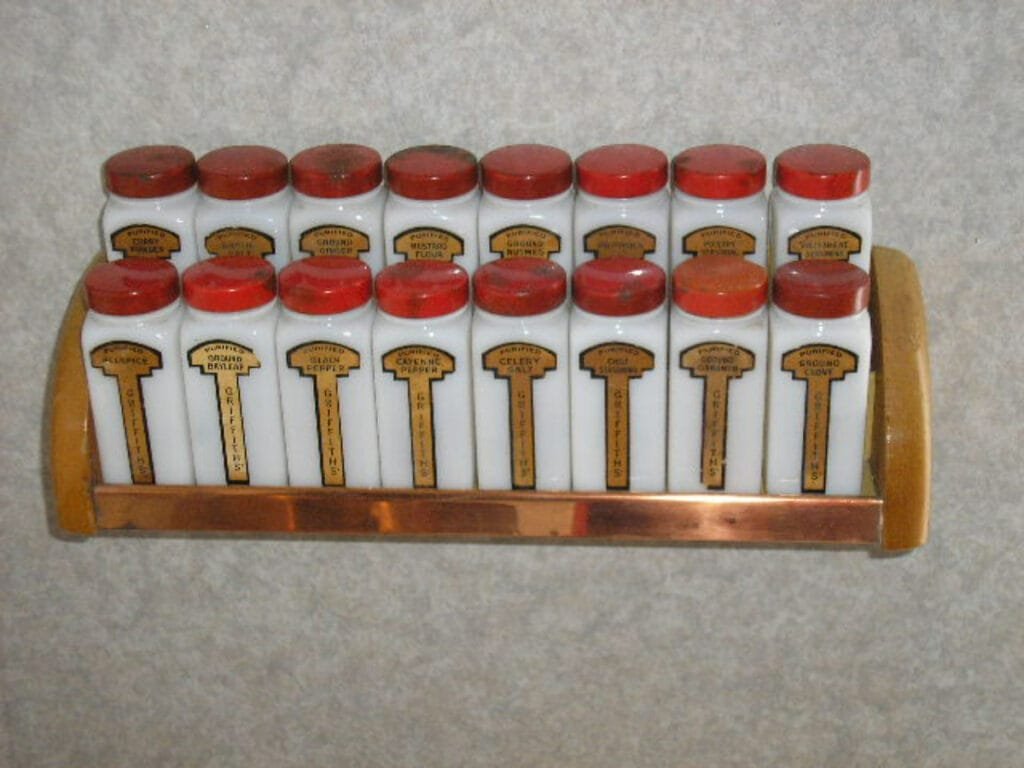
Markings are your best clues to spot a real vintage spice jar. Not only will these marks tell who made them, but the logo style and brand identification may also help to track the exact age of the jars.
Generally, you’ll find the makers’ marks:
- On the bottom of jars (the most common spot)
- Under the lid
- On paper labels
- Printed on the jar itself
The most popular names that made quality spice jars that are super collectible today are:
- Lenox: These guys are known for their porcelain spice jars. You’ll find “Lenox” markings with gold stamps on these, often hand-painted and crafted.
- Griffith Laboratories: Griffith’s square milk glass jars are the most sought-after. You can spot these by their smooth bottoms and no mold seams, plus labels reading “Griffith Laboratories” or just “Griffiths.”
- John Wagner & Sons: Wagner made beautiful apothecary-style clear jars, which you can spot by the “Wagner” embossed on the bottom. Sometimes you’ll see “John Wagner & Sons” or “Ivyland, PA.”
- Hazel-Atlas: This company made millions of containers, including milk glass spice jars, from the 1920s through the early 1960s. Look for “H over A” embossed on the bottom, plus some mold numbers to spot these.
- Danbury Mint: They are known for their unique architectural landmark-shaped jars, like the “Spices of the World” set.
Design Printing Techniques
With continuous advancement in printing technologies, the method of printing used for spice jars is a solid clue to verify whether it’s vintage or not.
Hand-Painting:
Earlier jars, especially porcelain or ceramic, are hand-painted. You can spot them by individual brush strokes and varying color intensities. Sometimes you’ll find artist initials or pottery marks. These jars were painted over the base glaze, then fired again.
Decal Application:
You’ll find this often in mid-century milk glass spice jars. The patterns are transferred from the paper to the jar surface, so they look ‘applied’ instead of blended into the material!
Also, authentic vintage decals show their age via slightly raised edges and some wear or fading. Modern reproductions often have perfect decals that look too new.
Embossed Designs:
Some designs were created during the glass-forming process, in which the pattern is raised or recessed right in the glass. These were durable but limited design options. Later spice jars may also show etched designs.
Paper Labels:
Many mid-century modern spice jars feature paper labels glued to the jar surface. These are not reliable as they’re easily lost, torn, or worn off (with washing or continuous handling).
How to Know Which Old Spice Jars Are Valuable?
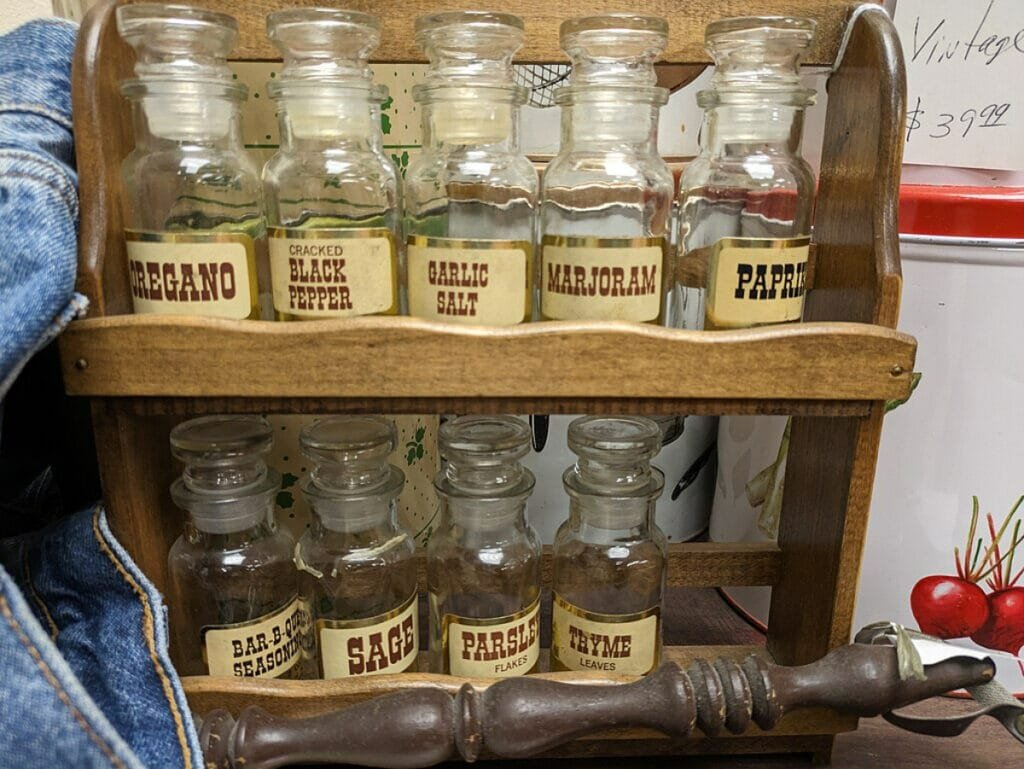
The real value of vintage spice jars comes down to four major factors. Below is a breakdown of those factors and how they impact the worth.
1. Condition
Just like other antiques, old spice jars in good condition will be way more valuable than those with heavy damage. Look for perfect pieces that have no chips, cracks, or damage, show intact original finish, hardware works, and clear maker’s marks; these are the premiums.
Collectors are also fine with minor damage or wear (appropriate for their age), like label fading, light scratches, or small chips that don’t affect the functioning!
But severe damage, including deep cracks, missing lids, or corrosion, can significantly kill the value.
2. Rarity
After condition, rarity is the second most important factor that decides if a spice jar is valuable or not! Why? Because even slightly damaged pieces can be worth a decent price if they belong to a rare set. The rarer a jar or set, the more it’s worth.
The following features show whether a jar is rare or not:
- It’s a part of a limited series: Some spice sets were made in tiny quantities, while others had limited distribution. Such pieces are rare. For example, Lenox made their Walt Disney spice jars in 1995 in small numbers; these sell for a thousand or more!
- It’s a part of a discontinued line: Companies discontinued their unpopular lines quickly. Pieces from these lines “failures” often become the most collectible.
- Subscription lines: Sets that were released like a monthly subscription (a new jar from the set delivered every month) are rare, like Lenox’s Spice Village.
2. Completeness
Needless to say, complete sets of spice jars from a single line or of the same pattern bring premium prices. A 24-piece Griffith set might sell for $200, but individual jars from the same set bring maybe $10 each.
So, you need all original jars, the matching rack, and coordinated lids. Partial spice jar sets, as well as missing pieces or mismatched elements, can hurt the final value!
3. Original Packaging
Original boxes can also add serious value and prove authenticity to old spice jars. The graphics, company information, and age-appropriate wear all matter.
So, look for things like boxes, instruction booklets, promotional materials, or old price tags. All these can help establish provenance and boost the value of sets!
11 Examples of Valuable Vintage Spice Jars to Collect!
Now that you know how to spot real vintage spice jars and how to assess their worth, here are some super rare and valuable pieces you need to find NOW!
1. 1995 Lenox Cats of Distinction Spice Jar Set
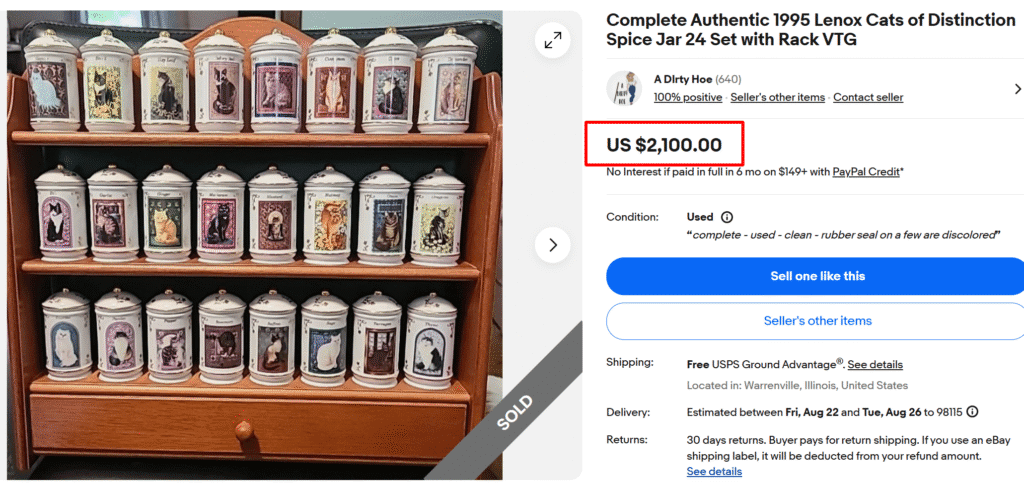
This complete Lenox Cats of Distinction set from 1995, designed by renowned artist Lesley Anne Ivory, is the most valuable spice jar collection you will ever see. It has 24 porcelain spice jars, each with a unique, colorful cat portrait with 22K gold trim and a floral border, arranged on a wooden rack.
From Persian cats to Siamese, you’ll find every breed here, each representing a different spice. You will find the Lenox 1995 marking, along with the series name, on the bottom of each jar.
Thanks to its rarity, a complete, clean set with original wooden rack can sell for up to $2,000 or more!
2. Lenox Spice Garden Porcelain Spice Jars Set
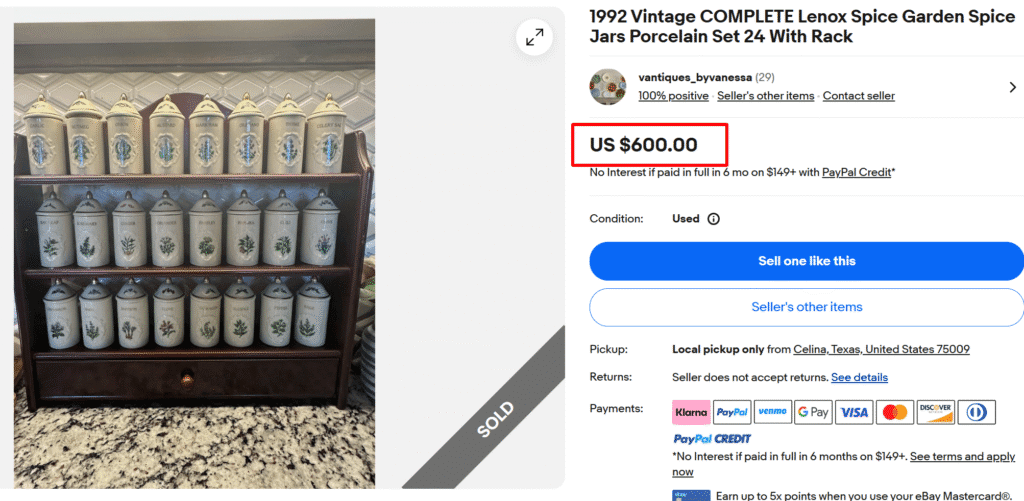
Another Lenox set with 24 porcelain spice jars, this one features an ivory background and a detailed botanical illustration of the actual spice plant inside a raised wreath design. Also, these jars have silicon seals on the lids, making them actually functional for storing spices.
With the original wooden rack, this set can easily sell for $500 to $1,500+, based on the condition and completeness.
3. Lenox Spice Village House Set (24 Pieces)
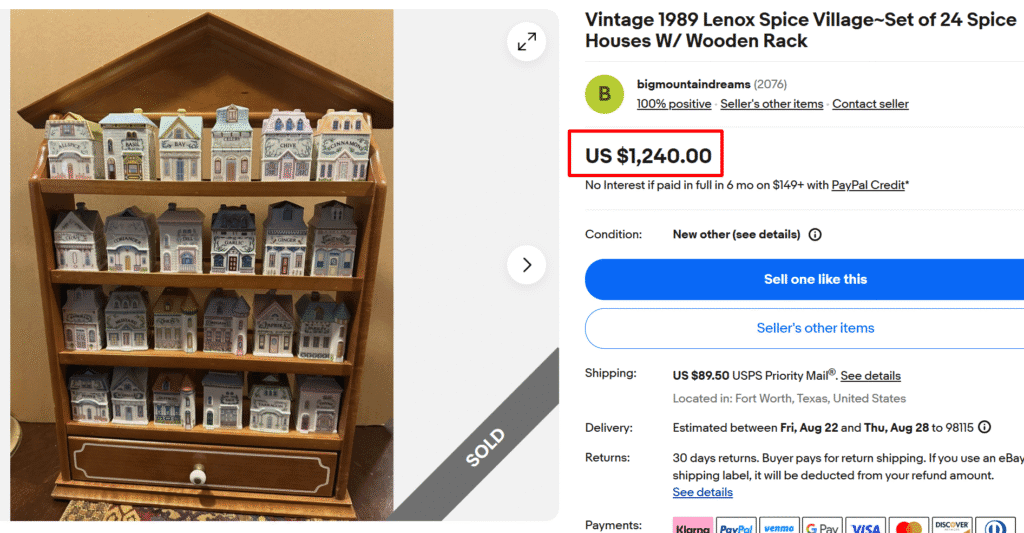
One of the most collectible spice jars, this is a Lenox Spice Village set including 24 porcelain jars, each shaped like a little painted house. Originally sold through a monthly subscription service, people received one house jar each month until they had their complete village.
These jars are highly collectible for their fine hand-painted details in dreamy pastels. Also, every house has its unique architecture, from Georgian townhouses to Swiss chalets, all decorated with botanical accents and 24K gold trim.
With original boxes and racks, a complete, unused set like this can be worth $500 to $2,000!
4. Lenox Seaside Lighthouse Spice Jars Set
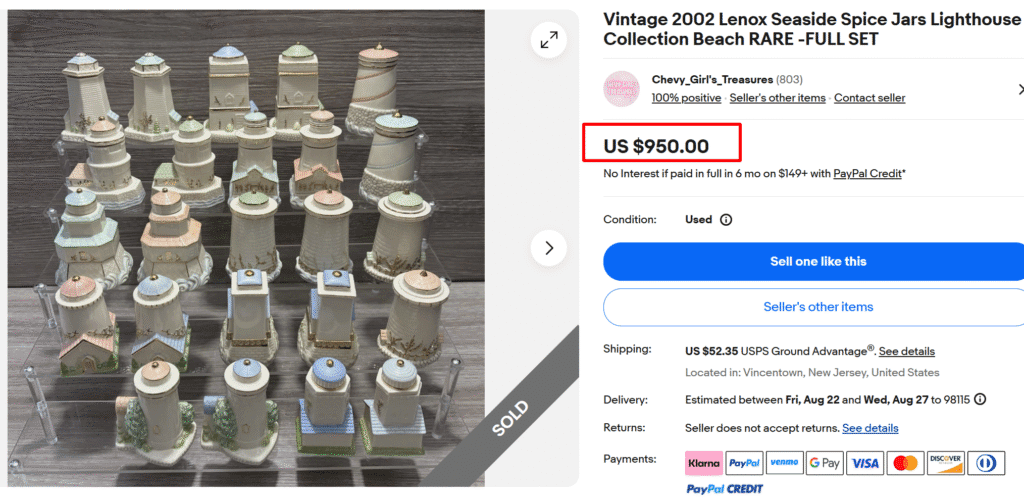
This is a Lenox Seaside collection from 2002, featuring porcelain spice jars shaped and hand-painted in pastel colors to look like individual lighthouses. You will also find 24K gold accents on all the jars with a pastel dome lid.
What makes this set incredibly rare is that Lenox only produced this collection for a short time, making complete sets of 24 lighthouses extremely hard to find; no wonder this set sold for over $900!
5. Danbury Mint Spices of the World Jars Set
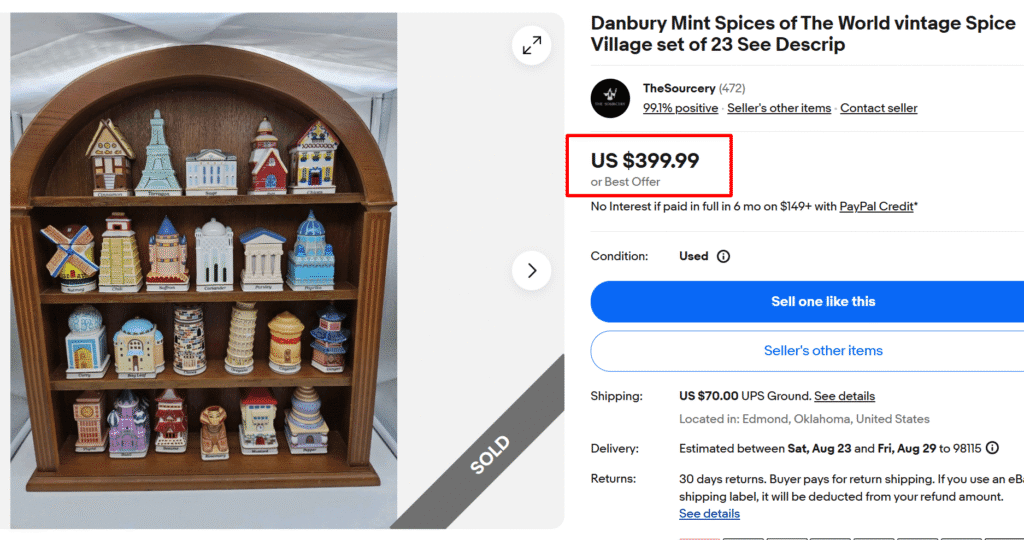
This Danbury Mint “Spices of the World” set of 23 porcelain spice jars is a collector’s dream, especially for those who love traveling! Each jar of this set is designed to look like global landmarks or buildings, like the Eiffel Tower from Paris, the White House from the USA, the Leaning Tower of Pisa, and many others!
Collectors love these jars for their bright colors and painting details that mimic the real structures. Depending on the presence of the rack and its condition, as well as the jars’ condition, a complete Danbury Mint set like this can easily fetch $300 to $800!
6. Tipp City Rooster Milk Glass Spice Jars
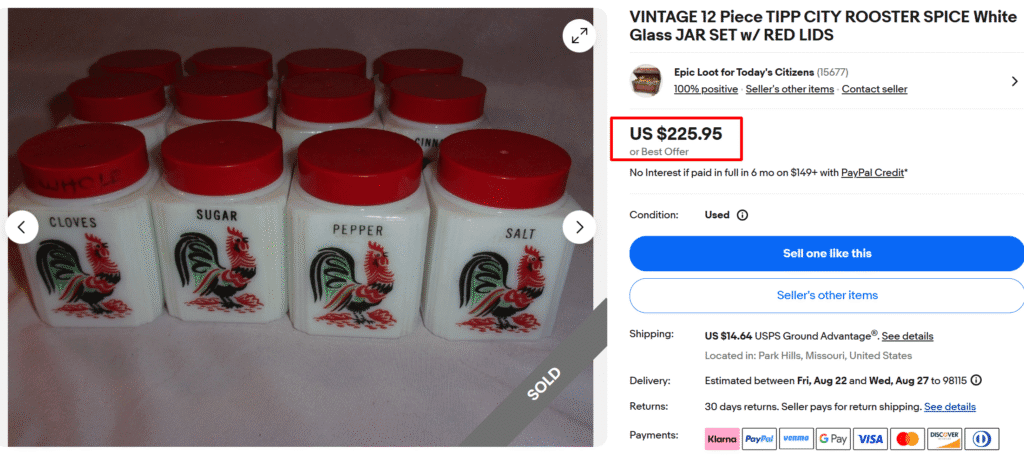
This Tipp City set has farmhouse appeal with 12 square milk glass spice jars decorated with bold yet adorable red roosters and matching red screw-on metal lids. Each jar bears its own label to keep spices organized.
Made by McKee Glass and decorated by Tipp City in the 1940s-50s, these square jars originally came with their own metal rack. A complete set, especially with the stand, can be worth up to $250 to $300. This one without the rack fetched over $220!
7. Jeannette Jadeite ALLSPICE Spice Canister
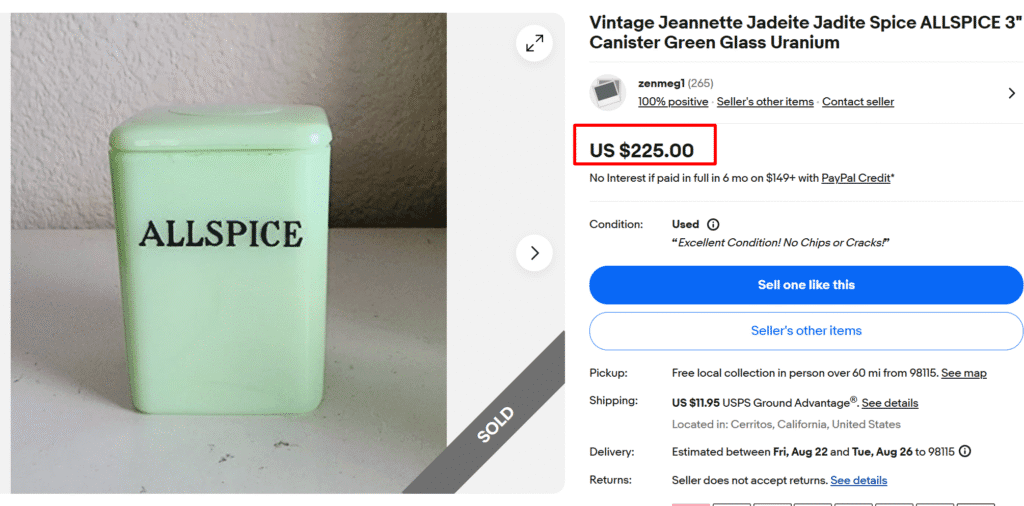
This is a rare, 3-inch ALLSPICE canister made from Jeannette jadeite glass, which contains uranium and glows under black light. Old spice jars made of unique materials are always valuable, like this piece sold for over $220!
Originally part of a four-spice set that sold for just around $4 back in the day, individual pieces like this ALLSPICE jar now typically command around $60-75. A full set can be worth up to $300 to $500!
8. Griffith Milk Glass Spice Jars Set Metal Lids
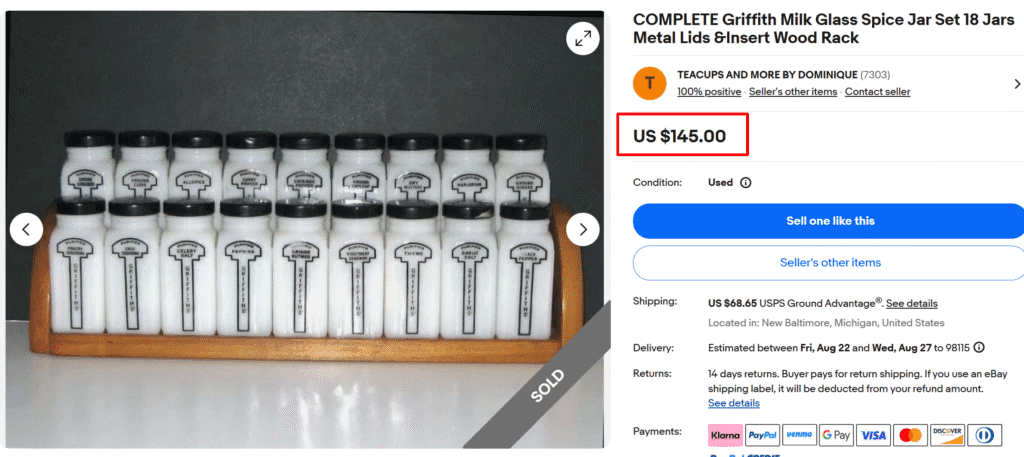
This Griffith set of 18 milk glass spice jars has the classic farmhouse look, each with vintage labels, black metal lids, and a wooden rack. Griffith spice jars are collectible because milk glass jars don’t often survive with their matching lids and racks intact! If found, it can easily sell for up to $200+!
9. Aluminum Kromex Pink Spice Jars Set
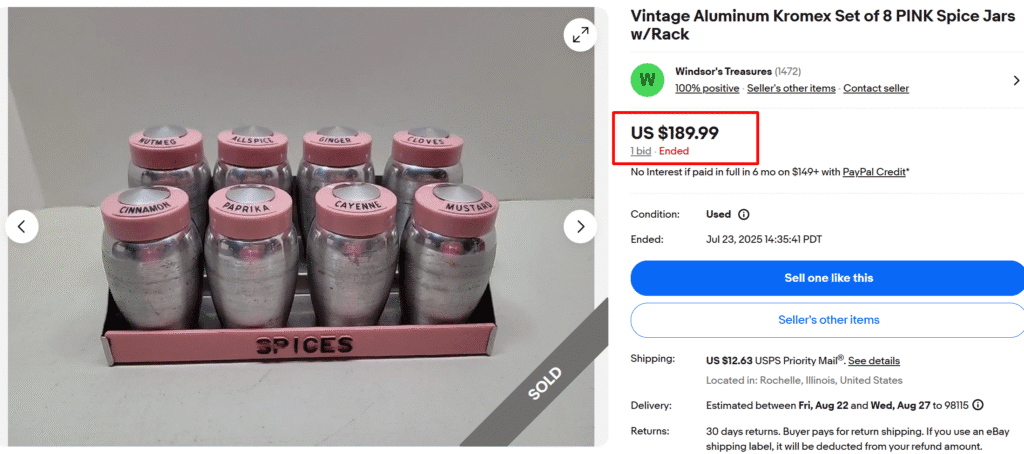
This is a vintage Kromex set with eight shiny aluminum jars, each with a retro pink lid and clear labels for spices like cinnamon and nutmeg. The set generally comes with a pink metal rack, too, making it a complete mid-century set.
Collectors like Kromex for adding color to vintage kitchen displays, and complete sets are valuable because it’s hard to find all the jars with the original rack still together. Rack included, these sets can sell for $100 to $250, depending on condition.
10. Hoosier Colonial Spice Jar Carousel Set
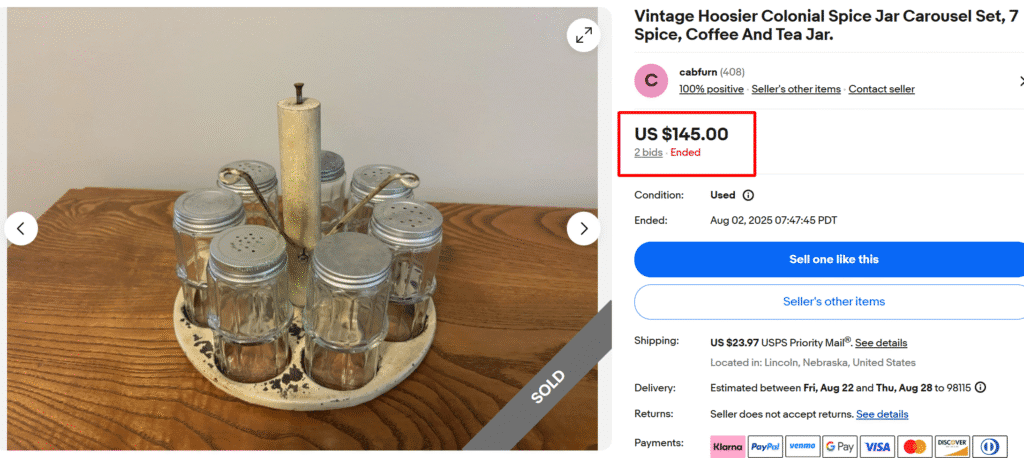
This Hoosier Colonial spice jar set is a classic kitchen piece with seven glass jars with a distinctive Colonial pattern and metal (aluminum perforated) shaker lids. What makes this set special is the rotating wooden carousel that holds everything together.
Also, the set includes jars for common spices plus tea and coffee. You can expect these sets to sell for $100 to $250 in excellent condition and with all the elements intact!
11. MCM Hanging Teardrop Mushroom Glass Spice Jar Set
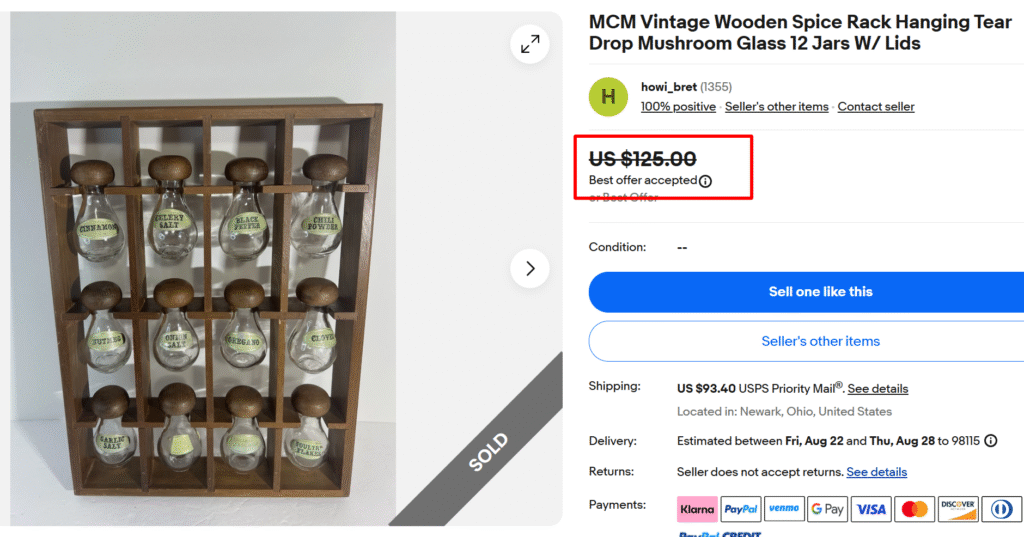
These vintage spice jars will appeal to mid-century modern fans! It’s a set of 12 clear glass teardrop-shaped jars that have chunky wooden mushroom lids. Each jar is labeled for common spices, and they sit in a wall-hanging, paneled wooden rack.
Since glass jars like these break off easily, finding a complete set like this with the original rack can be a great deal. Besides, these sets stand out for their distinctive style and practical design, making them collectible!
Note: This article is intended for informational, educational, and entertainment purposes only. Some images are illustrative and may not represent actual brands, products, or related entities. All trademarks, product names, brand logos, packaging, and other intellectual property referenced remain the exclusive property of their respective owners. Any brand mentions or references are provided solely for descriptive and educational context and do not imply any formal or commercial association.

